All-American Apple Pie
Apples, Pie Crust, and suddenly you have something magical.
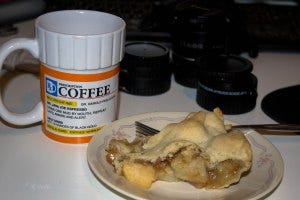
This started with me picking up a bagful of granny smith apples on sale. My First Reader loves pie, and apple is one of his favorites. He likes granny smith as eating apples, I prefer mine a little sweeter. But for baking, the granny smith is superior in that it's tart, keeps it's shape, and doesn't turn into applesauce in the pie. Don't, for example, use a macintosh apple in a pie, unless you like mushy filling. But I digress.
Apples are the easy part. They sing with flavor when combined with a little sugar, spice, and a sprinkle of flour to sop up the juices. It's the crust that stumps most beginning bakers. Now, you can cheat around it, and create an Apple Crisp, with no crust, just a struesel topping on apples. Delicious...
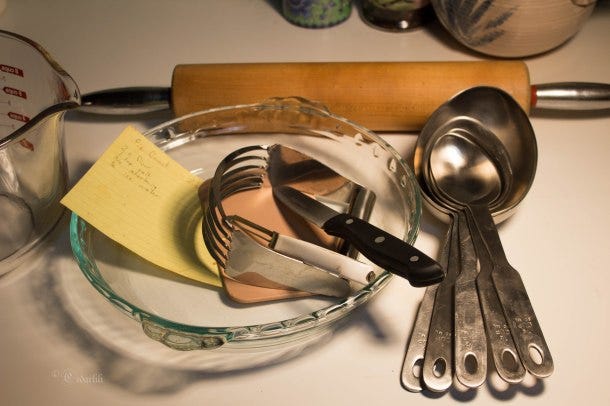
Tools for making pie: mixing bowl, measuring spoons, pie plate, rolling pin, pastry blender, knife, and a peeler. The scraper in the bottom of the plate is handy to clear the rolling surface of excess flour before washing it clean.
My recipe for pie crust is simple:
2 c flour (white, whole wheat is lovely, but not in a pie crust)
1 tsp salt
3/4 c shortening (or butter or lard. But if you are using animal fats, reduce the amount to 2/3 c)
1/2 c ice water
mix the salt into the flour, then cut or rub the fat into the flour until well incorporated. I use a pastry blender, but fingers work, or a pair of butter knives. With butter, you want to go for pea-sized chunks. Shortening is similar, but lard (and this is why it is the best for crusts) will blend softly into the flour even when chilled thoroughly (I keep my lard in the refrigerator). Once this process is complete, mix the water in a tablespoon or two at a time. Now, here is where a lot of people go wrong. First, you don't want this to be a very tight, or stiff, dough. It should be plastic - more plastic than most playdough, for comparison. Second, you don't want to over-mix it, and activate the gluten. Tough crust is the result of overworking.
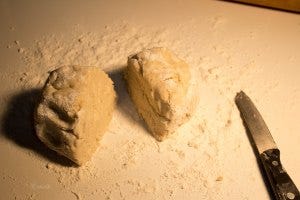
piecrust
Once the doughball is together - stop mixing as soon as the last bit of flour is incorporated! - then turn it out onto a smooth, floured surface. This recipe is for a double pie crust, or two crusts if you are putting struesel on top, or if you aren't making apple pie, but quiche, or... a million other things. I cut the ball into two more-or-less equal portions and set one aside. Working quickly and lightly, I push the reduced ball down to form a patty, then take my rolling pin to it, rotating it about a quarter-turn with each stroke. This keeps the dough forming in a circle. It's difficult to describe, I learned it from watching my mother and great-grandmother do it. I'm linking to Alton Brown's pie crust video. He includes a lot more steps than I use, but at about the 2:30' mark, you will see a technique for rolling out crust (I don't use the bag. You could... but I am a lazy cook. I don't do all his steps)
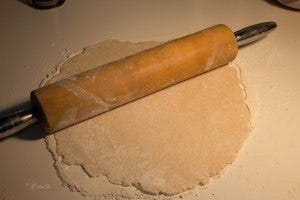
I also don't do his two-pan thing. Instead, when I have the dough the size I need (you can turn your pan upside-down on the dough to get an idea, it needs to be slightly larger than the pan to allow for it to line the full depth. If you are doing deep-dish, it needs even more space, and you may want to consider this when you are cutting your dough into two portions, making the bottom portion a bit larger) I fold it in half, then in half again, making a quartered sheet of dough. This can be handled, and I put it in the pan, then unfold slowly and carefully. If it tears, just push and pat it back together, your dough will be plastic enough to let you do this if you haven't made it too dry. Alton in the video poked the bottom with the fork, which is correct only if you will be baking this crust alone. Don't bother for the apple pie.
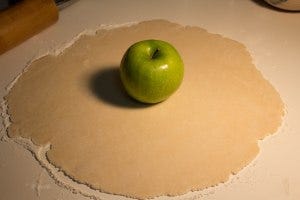
Smooth, round, and ready to fold up for moving.
Now, you will put the apple filling into the pie tin. I was using a 9"round, regular depth pan for this recipe. If you are using a smaller tin, or a deep dish, you may want to adjust the amounts accordingly. Preheat the oven to 400degF about now...
Peel, core, and slice thinly 4-5 large apples
toss with 1/2 c flour
1/2 c brown sugar
1 tsp cinnamon
1 tsp ground ginger
You can optionally add some ground nutmeg, allspice, or just put in 2 tsp pie spice.
That's it. This made a tart filling with a nice warm ginger taste to it. You could add more sugar if you prefer, and change the spices up.
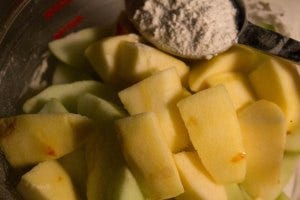
Apple pieces for pie (and the flour about to go on them).
Now, roll out the other dough ball, fold in quarters, and move to the top of the apple filling (you might want to give them a little wiggle, or arrange them so they aren't all sticking up. Apples are fun that way, like dumping a jenga game in the crust.) Unfold, and press the edges together. You can flute it prettily between your fingers if you want, or not. Trim off any excess. Cut a design in the top to allow for escaping steam. Place in the oven and set a timer for 15 minutes. When the timer goes off, reduce the heat to 350 degF and set the timer for another 35 min. When the top is golden brown, and you can hear the filling inside bubbling (or see it at the cuts in the top) the pie is ready to come out. Allow to cool for a bit (right now, it's full of hot lava. HOT sticky sweet lava, but did I mention HOT!) and serve while warm. Many people like to have it with a scoop of vanilla ice cream, a slice of cheese, or even a pat of butter on top, but it can carry the flavor all by itself.

The filled pie, arranged a bit to accommodate the crust
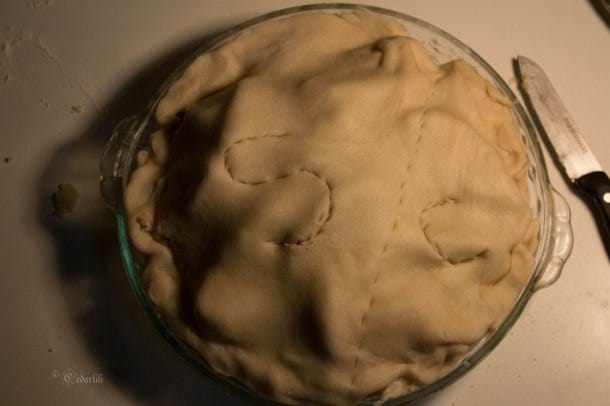
top crust on, neatly tucked and pressed tight around the edges.
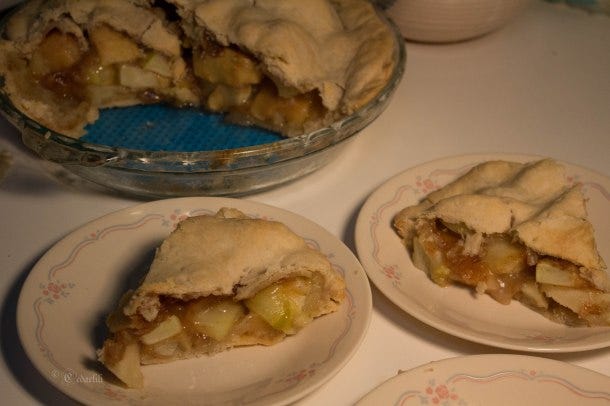
Finished pie! The lard crust is unbelievably tender and flaky. The First Reader says it's the only crust he's ever had he wanted to eat all of it, every last crumb.




